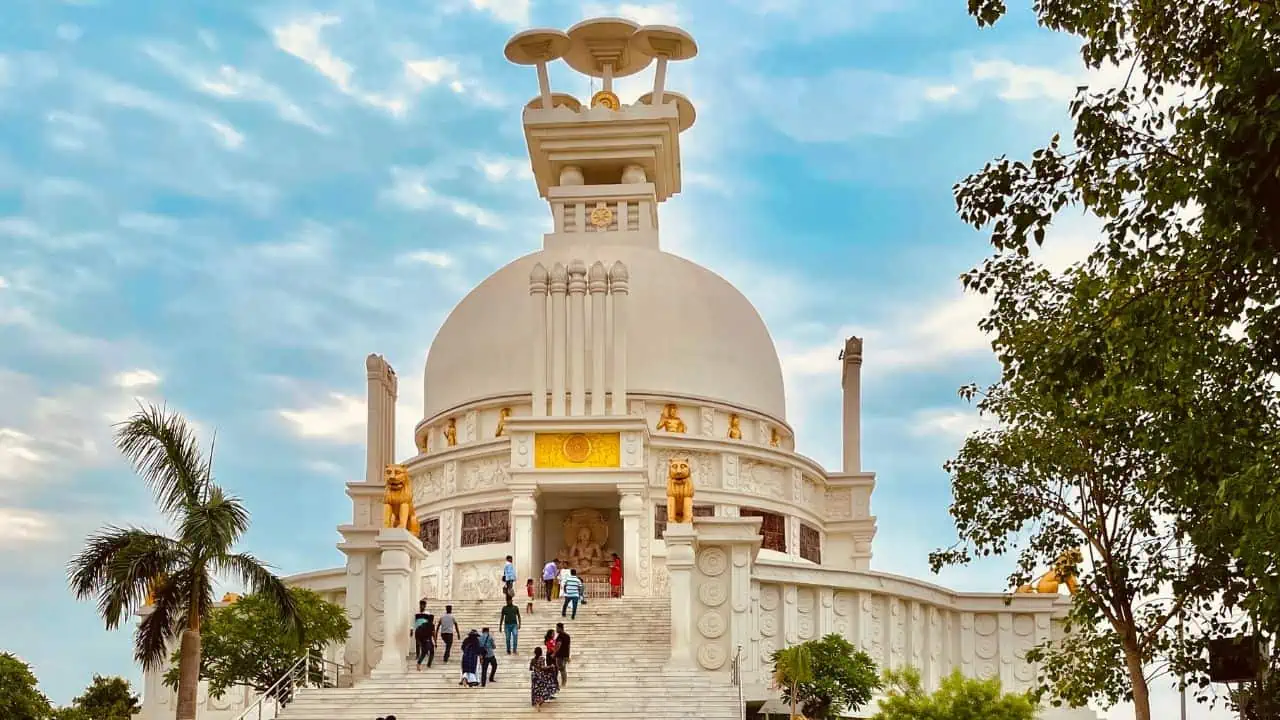Dhauli Giri Hills Shanti Stupa History, Opening Times, Ticket Price, and Things to Do
In the heart-stirring landscapes of Odisha, the Dhauli Giri Hills stand as a testament to the transformative power of peace and harmony. The Shanti Stupa, crowning its lush expanse, whispers tales of ancient bloodshed turned into a beacon of tranquility, painting a vivid picture of India’s rich history and profound spiritual heritage.

Delving deep into the heart of Dhauli Giri Hills, one is embraced by a symphony of silence that echoes far beyond the marble edifice of the Shanti Stupa. This masterpiece of architecture is not just a monument—it’s an embodiment of the metamorphosis of King Ashoka, the ripple effect of his enlightenment shaping centuries of Buddhist tradition.
Consider reading: Best Places to Visit in Bhubaneswar
Dhauli Giri Hills Opening Times and Ticket Price
| Details | Opening Time | Closing Time | Entry Fee | Light and Sound Show |
|---|---|---|---|---|
| Dhauli Giri Hills | 6:00 am | 6:00 pm | No entry fee | N/A |
| Light and Sound Show | N/A | N/A | 25 per person | 10 for students |
Please note that the Light and Sound Show is conducted every day in the evening, except on Mondays.
Consider reading: Udayagiri and Khandagiri Caves Opening Times, How to Reach and Photos
Why Dhauli Giri Hills Holds a Special Place in History
Dhauli Giri Hills is presumed to be the area where the Kalinga War was fought.
In 272 B.C., after witnessing the aftermath of this battle, Ashoka the Great was so horrified by the destruction that he transformed from a ruthless conqueror to a follower of Buddhism. He dedicated the rest of his life to spreading the teachings of Buddha.
At Dhauli Giri Hills, carvings of an elephant’s head and forelegs, which are said to be India’s oldest rock-cut sculpture, mark the spot where Ashoka’s transformation occurred. This sculpture symbolizes the birth of Buddha and the emergence of Buddhism.
Also, rock edicts at the bottom of the hill dating from 260 B.C. reveal Ashoka’s instructions to his administrators on how to rule his subjects. These edicts shed light on Ashoka’s miraculous transformation and his dedication to the Buddhist way of life.
Consider reading: History of Odisha
The Historical Significance of Dhauli Giri Hills
The Aftermath of the Kalinga War: Transformation of Emperor Ashoka
The great Emperor Ashoka, renowned for his governance in ancient India, experienced a profound transformation in the aftermath of the Kalinga War.
This was a paradigm shift, not only for the monarch himself but also for the entire Mauryan Empire.
The war, noted for its unprecedented bloodshed, filled Ashoka with remorse and initiated his journey towards Dharma. It was the profound grief and guilt that spurred the Emperor to embrace Buddhism and propagate peace, a stark contrast to his erstwhile belligerent persona.
A Testament to Peace: The Ashoka Edicts
In response to the transformative epoch in Ashoka’s life, the emperor inscribed his newfound principles of peace, non-violence, and Dharma on large stones and pillars.
These edicts, known as Ashoka Edicts, are spread across the Indian subcontinent, with Dhauli Giri Hills housing one such significant edict. It resonates with Ashoka’s deep commitment to Dharma and offers insight into his humanistic philosophy.
Consider reading: Nandankanan Zoological Park Opening Times, How to Reach and Photos
Exploring the Dhauli Giri Hills Landscape
Dhauli Giri Hills offers a panoramic view of Bhubaneswar City and the beautiful Daya River.
The most notable attractions are the Shanti Stupa and Ashokan Rock Edicts. The Shanti Stupa, or Peace Pagoda, is a popular tourist attraction with magnificent architecture and sculpted images of Lord Buddha.
Ashokan Rock Edicts, located at the foot of the hills, feature Emperor Ashoka’s teachings of Buddhism carved on rocks, cave walls, and pillars.
Other attractions include the scenic Daya River, a spectacular Light, and Sound Show depicting the life of King Ashoka and the Kalinga War, and the ancient Hindu Dhabaleswar Temple.
The Majestic Ashoka Pillar: Architectural Marvel of Ancient India
The Ashoka Pillar, an architectural marvel, stands tall as an emblem of ancient Mauryan craftsmanship.
Intricately carved and meticulously structured, the pillar is the epitome of the architectural prowess of the Mauryan era. It is a tribute to the epoch of Buddhism and a constant reminder of the transformative power of peace.
The Intriguing Shanti Stupa: A Beacon of Peace and Harmony
The Shanti Stupa, a serene white dome, crowns the Dhauli Giri Hills, radiating tranquility amidst the verdant landscape.
This beacon of peace and harmony was established by the Japanese Buddha Sangh and the Kalinga Nippon Buddha Sangh in the 1970s.
It stands as a testament to the enduring Buddhist values of peace and non-violence that permeated the region following Ashoka’s reign.
Dhauli Giri Hills: A Canvas of Lush Greenery and Breathtaking Vistas
The Dhauli Giri Hills, with their verdant greenery and panoramic views, offer a tranquil respite from the hustle and bustle of city life. The hills are a canvas painted with vibrant shades of green, punctuated with the mesmerizing hues of the sunrise and sunset. It is a haven for nature enthusiasts and peace seekers, offering a serene atmosphere that replenishes the soul.
Religious Significance of Dhauli Giri Hills
Dhauli Giri Hills: The Cradle of Buddhism in India
The Dhauli Giri Hills hold a pivotal place in the annals of Indian history, being the cradle of Buddhism in India.
The hills, drenched in tranquility, resonate with the peaceful chants and teachings of Buddhism. It is here that Buddhism first took root in India, spurred by Emperor Ashoka’s transformation and commitment to Dharma.
The Sacred Dhavaleswara Temple: A Testament to Lord Shiva’s Omnipresence
The Dhavaleswara Temple, dedicated to Lord Shiva, stands in stark contrast to the Buddhist monuments that dominate the landscape. This temple is an affirmation of the spiritual diversity of India, where different faiths coexist harmoniously. The temple, with its tranquil aura, is a testament to Lord Shiva’s omnipresence and the pervasive spiritual essence of Dhauli Giri Hills.
Cultural Experiences in Dhauli Giri Hills
Vibrant Festivals: The Pulse of Dhauli Giri Hills
The pulse of Dhauli Giri Hills is best felt during the vibrant festivals that animate the region with their energy and color. Notably, the annual Dhauli-Kalinga Mahotsav is a spectacular showcase of Indian classical and martial dance forms, drawing performers and spectators from far and wide. It is during these celebrations that the cultural richness of Dhauli Giri Hills truly comes to life.
Cultural Fairs and Celebrations: A Glimpse into the Local Life
The cultural fairs and celebrations in Dhauli Giri Hills offer an authentic glimpse into the local life.
The festivities are a confluence of tradition, art, and culture, with artisans showcasing their exquisite craftsmanship, folk dancers performing traditional dances, and locals enthusiastically participating in the revelry.
These fairs are a vibrant tapestry of cultural nuances that provide a deeper understanding of the region’s heritage.
Consider reading: Nicco Park Bhubaneswar Opening Times, How to Reach and Photos
Planning Your Visit to Dhauli Giri Hills
How to Reach Dhauli Giri Hills: Getting There is Half the Fun
Getting to Dhauli Giri Hills is an adventure in itself. Located at a distance of 8 km from Bhubaneswar, the state capital of Odisha, it is accessible by road and offers a picturesque journey.
Whether you’re on a bus winding through the lush landscapes or driving yourself, the journey to Dhauli Giri Hills promises to be an enchanting experience.
When to Visit Dhauli Giri Hills: Seasons of Serenity and Celebration
The best time to visit Dhauli Giri Hills depends on what you seek. The winter months, from November to February, offer a pleasant climate, ideal for sightseeing and exploration.
However, if you wish to immerse yourself in the local culture, the festival season, particularly during the Dhauli-Kalinga Mahotsav, offers a vibrant cultural experience.
Consider reading: Rajarani Temple Opening Times, How to Reach and Photos
Essential Tips for First-Time Visitors To Dhauli Giri Hills: Making Your Trip Memorable
For first-time visitors, it’s essential to respect the sanctity of the monuments and the local customs.
Dress modestly, particularly when visiting religious sites, and avoid littering. Engage with the local community, try the traditional cuisine, and participate in the cultural festivities to make your trip to Dhauli Giri Hills a memorable experience.
While visiting Dhauli Giri Hills, please note that shoes must be removed before entering the Shanti Stupa. Wearing hiking shoes is advisable while climbing the hills.
It is recommended to visit in the morning to avoid crowds and high heat later in the day. Wearing a cap or hat and carrying drinking water is also suggested.
Cameras are allowed on the premises, and parking facilities are available at the site.
Consider reading: Lingaraj Temple Location, Timing and Full Details
Final Thoughts on Dhauli Giri Hills
In conclusion, Dhauli Giri Hills and the magnificent Shanti Stupa resting atop is not just a captivating spectacle to behold but a symbol of tranquility and peace that echoes through the annals of time. These pristine white pagodas, set against the verdant canvas of the hills, narrate tales of transformation and reconciliation that shaped the course of history.
As you traverse the winding paths leading to the Stupa, you’re not just walking on a tourist trail, you’re embarking on a journey of historical discovery and spiritual awakening.
Each visit to this sacred hill is like turning a new page in the grand book of history, with countless narratives waiting to be unfolded and comprehended.
The magic of Dhauli Giri Hills and Shanti Stupa goes beyond the visual beauty. It lies in the rich tapestry of history it weaves the serene ambiance it creates, and the spiritual enlightenment it offers.
As the story of Dhauli Giri Hills and the Shanti Stupa unfolds, you’re left with an indelible imprint on your heart, beckoning you to return, to discover, to learn, and to be at peace.
Remember, Dhauli Giri Hills and the Shanti Stupa are not just destinations; they are experiences that enrich your understanding of the world, that inspire and captivate, that echo with the whispers of history and resonate with the silence of spirituality.
The journey to these mesmerizing hills is an odyssey into the past, a pilgrimage into tranquility, and a voyage into the realms of spiritual enlightenment.
So, the next time you’re seeking a journey that moves beyond mere sightseeing and delves into the depths of history and spirituality, let the serene paths of Dhauli Giri Hills and the tranquil silence of the Shanti Stupa guide your way.
Embark on this journey, and let the echoes of history and the whispers of tranquility be your travel companions, enlightening your path and enriching your soul.
Like the article? Please share! Follow us on Instagram: Incredible Odisha





